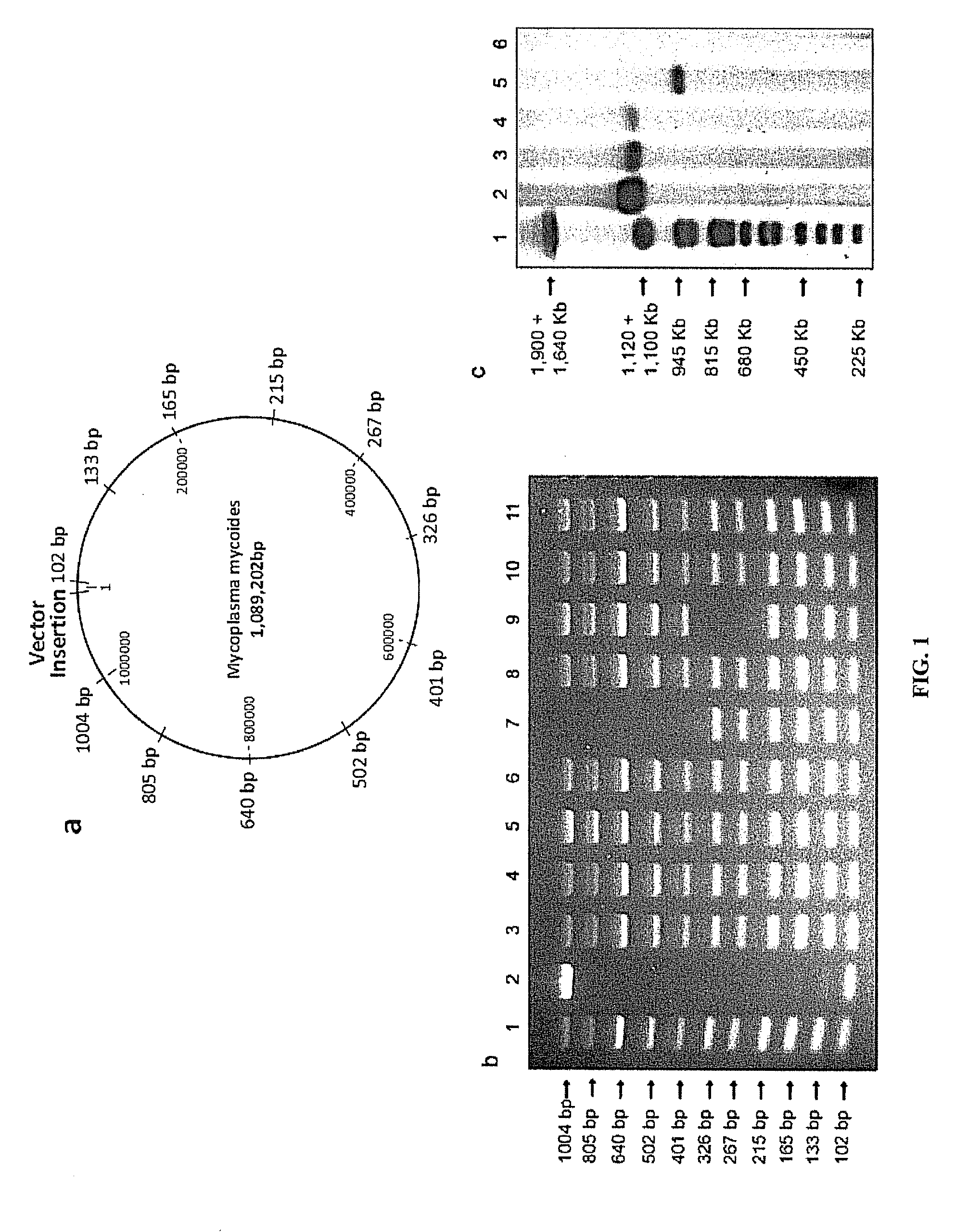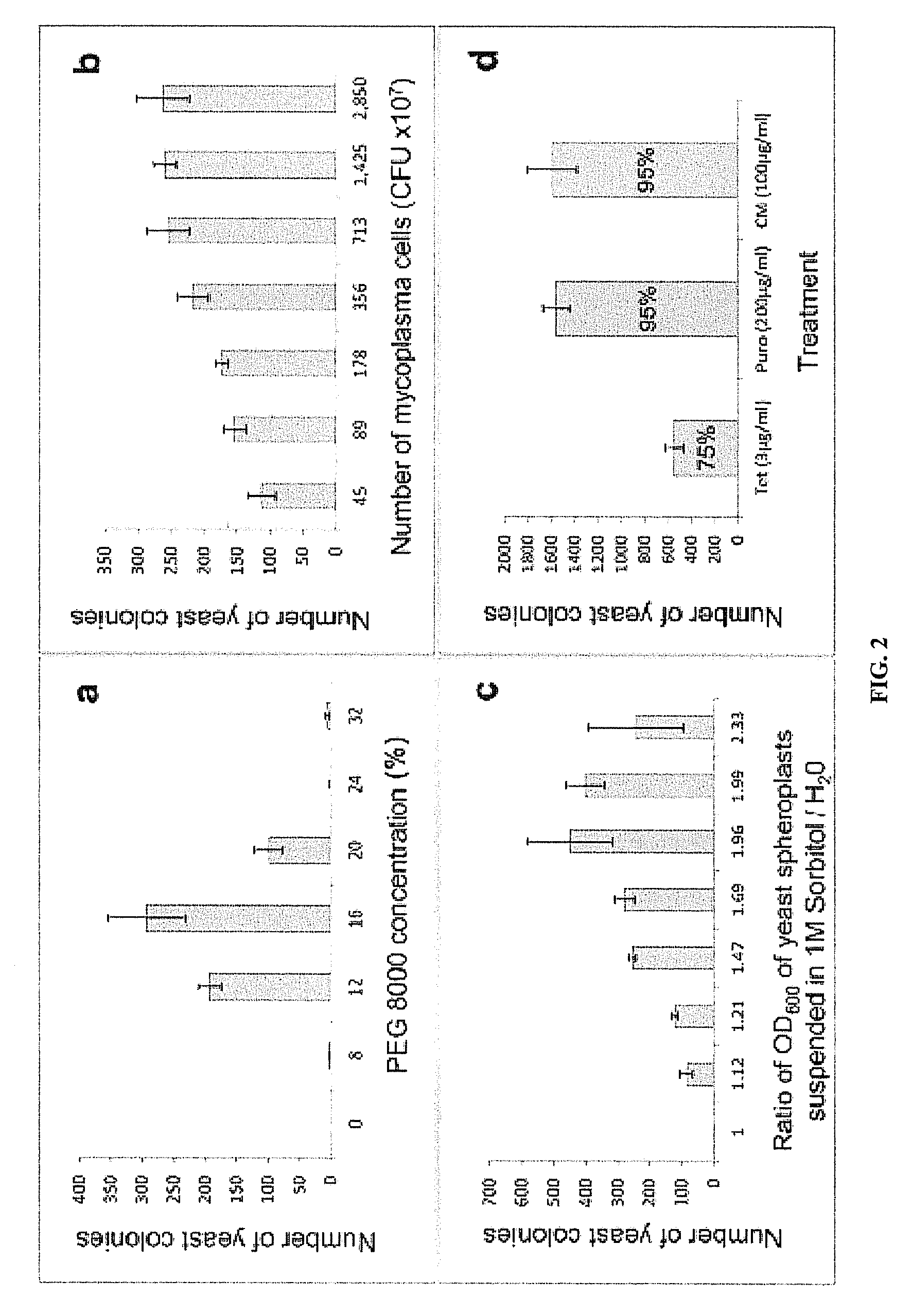Crowding agent-induced nucleic acid transfer into a recipient host cell
a technology of dna and host cells, applied in the field of cloning of genomescale dna, can solve the problems of limited cloning and modification of chromosomes and genomes in exogenous hosts, limited agarose plug procedures, and limited cloning and manipulation methods, so as to eliminate time-consuming steps of dna preparation and the effect of the same general applicability
- Summary
- Abstract
- Description
- Claims
- Application Information
AI Technical Summary
Benefits of technology
Problems solved by technology
Method used
Image
Examples
example 1
Transplantation of Mycoplasma mycoides Genome into Yeast Recipient Cells Using 16% PEG
[0116]In this example, the Mycoplasma mycoides strain YCpMmyc1.1 was used as the donor cell, which contained the selectable HIS3 marker, the yeast centromere (CEN6), and a yeast autonomously replicating sequence (ARS). The recipient heterologous host cell was yeast strain VL6-48.
[0117]M. mycoides cells were prepared by inoculating SP-4 media with M. mycoides glycerol stock culture. The culture was diluted ten times and grown to pH 6.5-7.0. 100 ug / ml chloramphenicol was added and cells grown for an additional 1.5 hrs at 37° C. The 50 mL culture was spun down at 8,000 rpm for 5 min at 10° C. After that, supernatant was removed. The pellet was resuspended in 50 mL of 0.5 M sucrose, 10 mM Tris-HCl, 10 mM CaCl2, 2.5 mM MgCl2, pH 7.5 solution. Cells were centrifuged at 10,000 rpm for 5 min at 10° C. and supernatant removed. Cells were resuspended either resuspension buffer (as above) for a final volume o...
example 2
Generation of a Restriction Nuclease Negative M. mycoides Strain and Transplantation of its Genome into Yeast
[0126]This example illustrates the effect on the efficiency of nucleic acid or genome installation or transplantation by using a restriction nuclease negative M. mycoides donor cell. M. mycoides wild type has six RM systems. An M. mycoides restriction nuclease negative strain from which all six systems were removed was generated, termed the JCVI-syn1.0, R0M0 strain. This strain has 0 restriction nucleases and 0 methyl transferases and was generated as follows:
[0127]The six restriction systems of the Mycoplasma mycoides JCVI-syn1.0 genome were removed in yeast, using a seamless deletion strategy known as TREC (Tandem repeat coupled with endonuclease cleavage) (Noskov, V. N. et al., Nucl. Acids Res. 38, 2570-76 (2010). In brief, the lithium acetate transformation procedure was used to introduce a cassette containing a URA3 marker, a tandem repeat, and the SCEI endonuclease gene...
example 3
Transplantation of Haemophilus influenzae Genome into Yeast Recipient Cells Using PEG
[0130]The nucleic acid or genome installation methods of the invention are also applicable to organisms having a complex cell wall structure. As a representative example the gram-negative bacteria H. influenzae (Rd strain KW20) is used. This strain uses standard genetic code and has a 1.8 Mb genome with 38% GC content.
[0131]H. influenzae cells were prepared by inoculating 40 ml of BHI media (containing hemin and nicotinamide adenine dinucleotide) with 1 ml of H. influenzae glycerol stock cultures (harvested at OD600˜0.3) and growing for 4 hrs at 37° C. at 200 RPM. 80 μl of Puromycin (50 mg / ml) was added and grown for additional 30 minutes. Cultures were spun down at 6,000 rpm for 5 min at 10° C. Cells were resuspended in 9 ml resuspension buffer (0.5 M Sucrose, 10 mM Tris-HCl, 10 mM CaCl2, 2.5 mM MgCl2, pH 7.5). 500 μl of 0.5M EDTA (pH=8), and 500 μl of lyzozyme (25 mg / ml, resuspended in H2O) was ad...
PUM
| Property | Measurement | Unit |
|---|---|---|
| concentration | aaaaa | aaaaa |
| concentration | aaaaa | aaaaa |
| pH | aaaaa | aaaaa |
Abstract
Description
Claims
Application Information
 Login to View More
Login to View More - R&D
- Intellectual Property
- Life Sciences
- Materials
- Tech Scout
- Unparalleled Data Quality
- Higher Quality Content
- 60% Fewer Hallucinations
Browse by: Latest US Patents, China's latest patents, Technical Efficacy Thesaurus, Application Domain, Technology Topic, Popular Technical Reports.
© 2025 PatSnap. All rights reserved.Legal|Privacy policy|Modern Slavery Act Transparency Statement|Sitemap|About US| Contact US: help@patsnap.com



